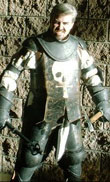|
|
This topic comprises 2 pages: 1 2
|
|
Author
|
Topic: SLR Photography Question About Lenses
|
|
|
|
|
|
|
|
|
|
|
|
|
|
|
|
|
|
|
|
|
|
|
William Hooper
Phenomenal Film Handler
Posts: 1879
From: Mobile, AL USA
Registered: Jun 99
|
 posted 03-29-2005 06:51 AM
posted 03-29-2005 06:51 AM





I don't know much 'bout them devilish digital cameras; yours may have anti-shake, autofocus, etc., & you may be specifically needing to use a digital camera for speedy export not requiring scanning, taking a bunch of pictures many of which you may want to throw away, etc.
Longer lenses have a problem with exacerbating lens shake. As light levels get lower, any blurring from longer exposures piles on top of lens shake to make things worse.
A flash is always irritating to subjects & other folks in the room.
If you want these long lenses in these small rooms so that you can pick out 1 or 2 faces from the back of the room, a flash won't help anyway.
If you get a faster lens (most longer zooms are slower, & much more expensive if faster), you start having depth of field problems & have to constantly ride focus. This may be less of an issue with autofocus cameras if you devise a technique that makes the autofocuser happy & always point where it wants to focus.
Zoom lenses with huge ranges (like 28-210) are always mch mushier-looking than primes. It's less of an issue with smaller zoom ranges (28-50, 110-250, whatever).
If they're small rooms & you want paparazzi-style photos of 1 or 2 individuals in the crowd, I think you don't need a wide lens like a 28mm or less, unless you're right up on them. With a f2.5 lens around 35-70mm & a bit of distance, if the light is decent, you won't need a flash. You will need to be steady, but that's a given with anything, & not as big a problem with longer lenses.
If it's got to be digital, I'd say a 35-70mm lens about f2.5 & a high resolution camera (4 megapixels, I dunno from megapixels), & crop out what you don't want.
You'll have problems if you get further back, have to stand on chairs, etc. to shoot over a crowd, etc.
If lighting gets low, then you'll need a flash, so you'll have to get still further back to keep from bugging folks, & so need a longer lens & a more powerful flash.
--
My pictures are different, & I'm primarily interested in wide spectacle shots in theaters with & without crowds. I'm have only been taking the Nikon FG out for a long while, & I've bought another.
![[john]](graemlins/john.gif) : :
http://mir.com.my/rb/photography/hardwares/classics/emfgfg20/fg/index.htm
They're the lightest, smallest Nikon made, use Nikon AIs lenses, & don't call attention to themselves. I do get some wandering through crowds shots, & the size makes pitcher-taking non-distracting or even unobserved. They're stupidly inexpensive, because they don't look like the dadgum space shuttle camera, but have TTL flash, excellent metering & autoexposure modes. There's something a little different about the center-weighted metering on the FG, but it adapts well for the big auditorium shots I do where the hot spots are scattered away from the center. You'll often find people selling them because they mistakenly think they're broken: the AE readout doesn't work until the frame counter is advanced to 1 (no freebie AE shots before frame 1).
Light, rugged; I have no straps on mine (except wrist straps) & instead have one of those spring-loaded belt loop clips like you put on huge keyrings. EASY for going up ladders & through crowds!
| IP: Logged
|
|
|
|
|
|
|
|
|
|
All times are Central (GMT -6:00)
|
This topic comprises 2 pages: 1 2
|
Powered by Infopop Corporation
UBB.classicTM
6.3.1.2
The Film-Tech Forums are designed for various members related to the cinema industry to express their opinions, viewpoints and testimonials on various products, services and events based upon speculation, personal knowledge and factual information through use, therefore all views represented here allow no liability upon the publishers of this web site and the owners of said views assume no liability for any ill will resulting from these postings. The posts made here are for educational as well as entertainment purposes and as such anyone viewing this portion of the website must accept these views as statements of the author of that opinion
and agrees to release the authors from any and all liability.
|

 Home
Home
 Products
Products
 Store
Store
 Forum
Forum
 Warehouse
Warehouse
 Contact Us
Contact Us




 Printer-friendly view of this topic
Printer-friendly view of this topic









![[thumbsup]](graemlins/thumbsup.gif) .
.
![[john]](graemlins/john.gif) :
:



